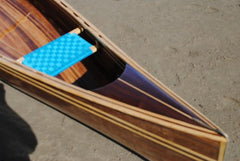Canoe Restoration: A Mini Masterclass in Canoe Repair
 Ted Moores, one of the minds behind Bear Mountain Boats, goes above and beyond to provide lifetime support to their customers. A recent email exchange with a customer who purchased plans from Bear Mountain Boats unveils the true essence of this commitment.
Ted Moores, one of the minds behind Bear Mountain Boats, goes above and beyond to provide lifetime support to their customers. A recent email exchange with a customer who purchased plans from Bear Mountain Boats unveils the true essence of this commitment.

The damage was enough that piecing it back together and patching was out of the question. The only solution was to mold a new section to replace the damaged portion.

The first step is to roughly mark off the area to be replaced to get an idea of the size to make the patch.

There are no flat surfaces in a canoe hull - everything is a compound bend - so the new section needs to be molded to the original shape. The repair area was covered with heavy plastic film to keep the new panel from sticking and protect the undamaged portion of the hull. The jig on top is like a reverse mold. It will be used to hold the new planks in position while being glued together as well as supporting the panel for shaping, sanding and glassing the inside.

Clamp the jig to the bench and position the panel, tacking the edges with 1” finishing nails. Set the heads below the surface so they won’t interfere with shaping and sanding. After shaping and sanding, lay up with one layer of glass and one coat of epoxy. When cured, the panel will hold the molded shape.

Trim the panel to size and position over the hole. Use an awl to scribe a very accurate shape onto the hull, then carefully trim to the line.

To support the panel during installation, Ted used a few little tabs. Cover the tabs with plastic packing tape and use two sided carpet tape for a temporary attachment to the inside of the hull.

Apply thickened epoxy to the edges, put in place then fasten to the tabs with #4 x 1/2” screws and a washer. Then use lots of plastic packing tape to hold it all together.

When the glue has cured, shape and sand.

Tape off the area to be glassed a couple inches outside the patch. One layer of glass and one coat of epoxy.

Use a sharp chisel to slide under the tape to trim the glass. When feathering the edge of the glass, be careful not to cut into the original glass around the patch. Finish with two more coats of epoxy.

Finish the inside with one more layer of glass, feather the edges and apply two more coats of epoxy. After the epoxy has cured, sand and varnish.
It can be devastating to have to repair something we have worked of hard on, but we are here to support you as you figure out your next steps. Adjustments to the steps above will be needed based on your boat's unique characteristics but rest assured, the support from Bear Mountain Boats remains unwavering—we're always here to help you navigate the waters of craftsmanship.

